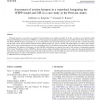Free Online Productivity Tools
i2Speak
i2Symbol
i2OCR
iTex2Img
iWeb2Print
iWeb2Shot
i2Type
iPdf2Split
iPdf2Merge
i2Bopomofo
i2Arabic
i2Style
i2Image
i2PDF
iLatex2Rtf
Sci2ools
ENVSOFT
2007
2007
Assessment of erosion hotspots in a watershed: Integrating the WEPP model and GIS in a case study in the Peruvian Andes
This paper presents a case study in assessment of erosion hotspots in an Andean watershed. To do this, we made use of an interface called Geospatial Modelling of Soil Erosion (GEMSE): a tool that integrates Geographical Information Systems (GIS) with the Water Erosion Prediction Project (WEPP) model. Its advantages are: (i) it is independent of any special GIS software used to create maps and to visualize the results; (ii) the results can be used to produce response surfaces relating outputs (e.g. soil loss, runoff) with simple inputs (e.g. climate, soils, topography); (iii) the scale, resolution and area covered by the different layers can be different among them, which facilitates the use of different sources of information. The objective of this paper is to show GEMSE’s performance in a specific case study of soil erosion in La Encan˜ada watershed (Peru) where the hillslope version of WEPP has been previously validated. Resulting runoff and soil loss maps show the spatial distr...
ENVSOFT 2007 | Soil | Soil Erosion | Soil Loss |
| Added | 13 Dec 2010 |
| Updated | 13 Dec 2010 |
| Type | Journal |
| Year | 2007 |
| Where | ENVSOFT |
| Authors | Guillermo A. Baigorria, Consuelo C. Romero |
Comments (0)

